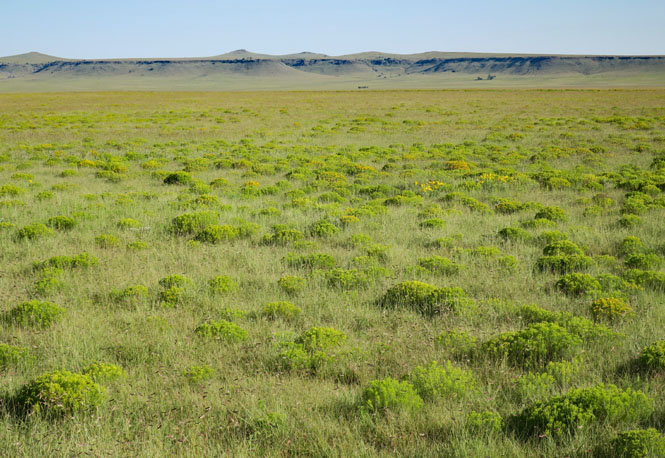August 26 - 29, 2017

Northern New Mexico is strikingly varied--from the wide-open plains in the east to the rugged Rocky Mountains in the center and the high mesa deserts of the Navajo Nation of the west.
My goal was to aim for the small town of Coyote (a place I hadn't been), but that was really only a way to get started. I'd change my routes along the way, mostly trying to pick up roads I've never ridden. As it turned out, I rode right through Coyote without even stopping (it's easy to miss).
 Kansas
Kansas
Years ago, center-pivot irrigation, such as this, would be a fountain of water, with the spray shooting in great circles such as you might see on a golf course. But, today, this is the norm. The spray is just inches above the crop, and you'll no longer see most of the water drifting off in the wind, only to evaporate before hitting any crop.
 Oklahoma
Oklahoma
If you like grand, uninterrupted vistas, you'll enjoy the Oklahoma
panhandle. New Mexico
New Mexico
Clayton, New Mexico.
I've stayed the night at the Eklund Hotel several times. The restaurant is excellent and the rooms are nice, too.

Highway 56, the route of the Santa Fe Trail.
Throughout this trip, I'd be seeing huge fields of yellow sunflowers.
Miami, New Mexico is a small place on New Mexico 199. Sometimes it's difficult to find anything that looks town-like for these photographs.
This stretch of highway 21 follows the old route of the Santa Fe Trail. That's the "Tooth of Time" formation in the distance. In the days of freight hauling in the nineteenth century, when you passed that rock, you were about a week from reaching your goal of Santa Fe.
The Cimarron Canyon on the way to Taos.
Looking over the Rio Grande valley southwest of Taos. Look close, and you'll see the river canyon in the center of the photograph. There aren't many bridges over the river.
The Rio Grande while following highway 68. Yes; it's yellow. It eventually clears.
Highway 96, riding towards Coyote.
This is "red rock" country.
It's very striking country, but you'd be advised to get fuel when you can.
Heading west out of Cuba, New Mexico. Off and on, this is Navajo Nation.
You could probably have a picnic on this road and not worry much about traffic.
Here (or nearby) is the continental divide.
Turning north on highway 371 towards the Chaco River and then Farmington.
 Colorado
Colorado
Following highway 140 and La Plata River towards the San Juan Mountains.
Yes; that's called Chimney Rock--not to be confused by a number of similar formations, all with that same name.
Highway 160 through the southern counties of Colorado.
Navajo Peak (13,409 ft.).
 New Mexico
New Mexico
The obvious crossing of the divide would be over Wolf Creek Pass (10,857 ft.), but that road has long been tamed and straightened and anyway, the route is now pretty busy. Instead, I'm dropping back into New Mexico to cross over Cumbres Pass (10,022 ft.).
Chama, New Mexico is one end of the Cumbres & Toltec Railroad.

Climbing towards the pass. That's highway 17 on the right and the rails in the center
 Colorado
Colorado
It's a nice view from the top looking north to the Conejos River and an unspoiled Rocky Mountain valley.
The Conejos River.
Antonito, Colorado is at the other end of the short line.

Manassa, Colorado is the hometown of Jack Dempsey, "The Manassa Mauler." I'm guessing the town is now smaller than it was when Dempsey was here.
Looking south down the San Luis Valley.
Blanca Peak (14,345 ft.) is the tallest of the grouping on the left and Mount Lindsey (14,125 ft.) is just to the left of where the road is pointing. This is part of the long Sangre de Cristo Range.
The Spanish Peaks. That's East Peak (12,683 ft.) on the left and West Peak (13,626 ft.) on the right--not difficult names to remember. These are the last of the Rocky Mountains. Keep going east and you'll very soon be in the great plains.
It's not really flat, but it can seem that way after spending most of the day riding in the mountains. Highway 10 runs between Walsenburg and La Junta, Colorado.
A nice trip. You cannot go wrong spending a few days in New Mexico.













































